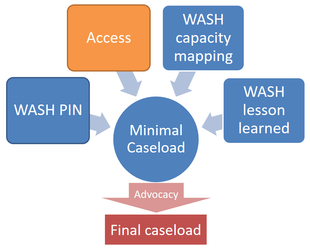Estimation of the humanitarian caseload
Understand the humanitarian profiling system
The cluster caseload represents the total number of people targeted by all partners of a cluster for the planned response. It should not be confused with the Population in Need (PIN), or the population reached or covered:
- WASH People in Need is the total number of people in need for WASH assistance during a humanitarian crisis. They usually cannot be all reached, because of lack of capacity or access problem.
- A more realistic target is therefore defined for the response, called caseload, or population targeted
- People reached by one or more activities are called the population reached, even if these activities are not done using agreed standards, and do not produce the expected change.
- When people are reached by activities done according to agreed standards and leading to the expected change for the beneficiaries, they can be considered as “covered”
| Humanitarian Population Figures | How to calculate WASH Cluster caseload |
There is no consolidated cross-sector method to calculate a cluster caseload. The GWC has developed a standard methodology, but which needs to be adapted to each context. The following steps can be followed:
- Use the WASH PIN numbers for each geographical zone as a starting point
- Use data on capacity to make a first caseload estimation (see following section)
- Use data on access to make a first caseload estimation (see following section)
Important differences between PIN and caseload can often be noticed. To increase the caseload , involves not only advocacy at all levels to gain access but also to enhance the capacity of partners with adequate resources, skills and tools do so.
Use data on capacity to make a first caseload estimation
The WASH humanitarian caseload is the part of WASH People in Need (PIN) that can be realistically targeted considering operational difficulties. Difficulties are usually measured in terms of operational and technical capacities of partners and access to target area (road access, security). To estimate the caseload, the WCC must therefore have an estimation of the capacity of the partners that will be involved in the response. If capacity was maximal and access not an issue, the whole population in need could be targeted, and the caseload would be the PIN. But as there are always capacity issues, the PIN must be reduced accordingly. WASH Capacity mapping is a long process that can take several months, so if a complete WASH capacity mapping exercise has not been done recently, a lighter and quicker evaluation of capacities needs to be done by the WASH coordination platform, for instance based on operational partner’s presence from the 4W.
In each geographical zone, an estimate of the number and operational capacity of WASH partners, and defining the maximum number of people that can be reached by the partners can be done if the maximum number of people is:
- above the PIN, then use the PIN number as your caseload: and
- lower than the PIN, then use maximum number of people than can be reached as your caseload.
Use data on access to make a final caseload estimation
In the same way as for capacity, as estimation of the planned access to target area is required to calculate the WASH caseload: even if capacity of partners is high, if they cannot reach the affected area because of bad road access in rainy season, risk of kidnapping or attacks on humanitarian convoys, then only a small percentage of the population can be reached.
- In areas where access is not a constraint, then caseload is defined only by partner’s capacity.
- In areas where there are a lot of security incident, or roads get flooded in rainy season, you can for example estimate that only half of the figures defined by partner’s capacity can be reached, and consider this new figure as your caseload
- In areas where there are less access issues, you can consider for example that ¾ of the figures defined by partner’s capacity can be reached, and consider this new figure as your caseload
Key web links

